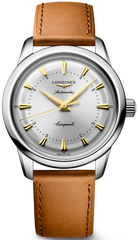Longines Heritage Watch Review
Friday - 17 August 2012

Longines has revealed two new Heritage timepieces to mark the brand's 180th anniversary.
The Telemeter Chronograph and Tachymeter Chronograph are said to "represent both the brand's rich history and extend Longines' Heritage segment with a combination of extraordinary technical features and a touch of elegance."
The Telemeter Chronograph and Tachymeter Chronograph are said to "represent both the brand's rich history and extend Longines' Heritage segment with a combination of extraordinary technical features and a touch of elegance."
Both watches have a 41 mm steel case, a white lacquered dial, and scratch-resistant sapphire crystal glass with several layers of anti-reflective coating on the underside. The models are equipped with calibre L688 self-winding mechanical movement with a column-wheel chronograph mechanism developed for Longines, visible through a transparent case back, and come with a black alligator strap.

The Longines Telemeter Chronograph is inspired by a Longines chronograph produced in 1933 and features a telemeter scale on the dial, to measure the distance travelled by sound - a function first introduced in 1852. If activated after a flash of lightening and stopped when thunder is heard, the hand of the chronograph will indicate the distance from the storm in kilometres. The telemeter scale and a spiral tachymeter scale appear in red, in contrast to the blued steel Breguet hands.

The Longines Tachymeter Chronograph features a tachymeter - a tool originally introduced in 1811 to measure the hourly pace of assembly lines and the velocity of the first modern means of locomotion. To measure hourly pace, the chronograph is started at the beginning of the task and stopped at the end, so the hand shows the average production pace per hour. The average velocity of a subject can be showed by activating the chronograph at distance zero and stopping once the distance of one kilometre has been covered. The tachymeter scale appears on the dial in blue (1000 m) and red (100 m). The watch has elegant blued steel Breguet hands, and a blued steel counter-weight line pear hand indicating the seconds.

The Longines Telemeter Chronograph is inspired by a Longines chronograph produced in 1933 and features a telemeter scale on the dial, to measure the distance travelled by sound - a function first introduced in 1852. If activated after a flash of lightening and stopped when thunder is heard, the hand of the chronograph will indicate the distance from the storm in kilometres. The telemeter scale and a spiral tachymeter scale appear in red, in contrast to the blued steel Breguet hands.

The Longines Tachymeter Chronograph features a tachymeter - a tool originally introduced in 1811 to measure the hourly pace of assembly lines and the velocity of the first modern means of locomotion. To measure hourly pace, the chronograph is started at the beginning of the task and stopped at the end, so the hand shows the average production pace per hour. The average velocity of a subject can be showed by activating the chronograph at distance zero and stopping once the distance of one kilometre has been covered. The tachymeter scale appears on the dial in blue (1000 m) and red (100 m). The watch has elegant blued steel Breguet hands, and a blued steel counter-weight line pear hand indicating the seconds.









